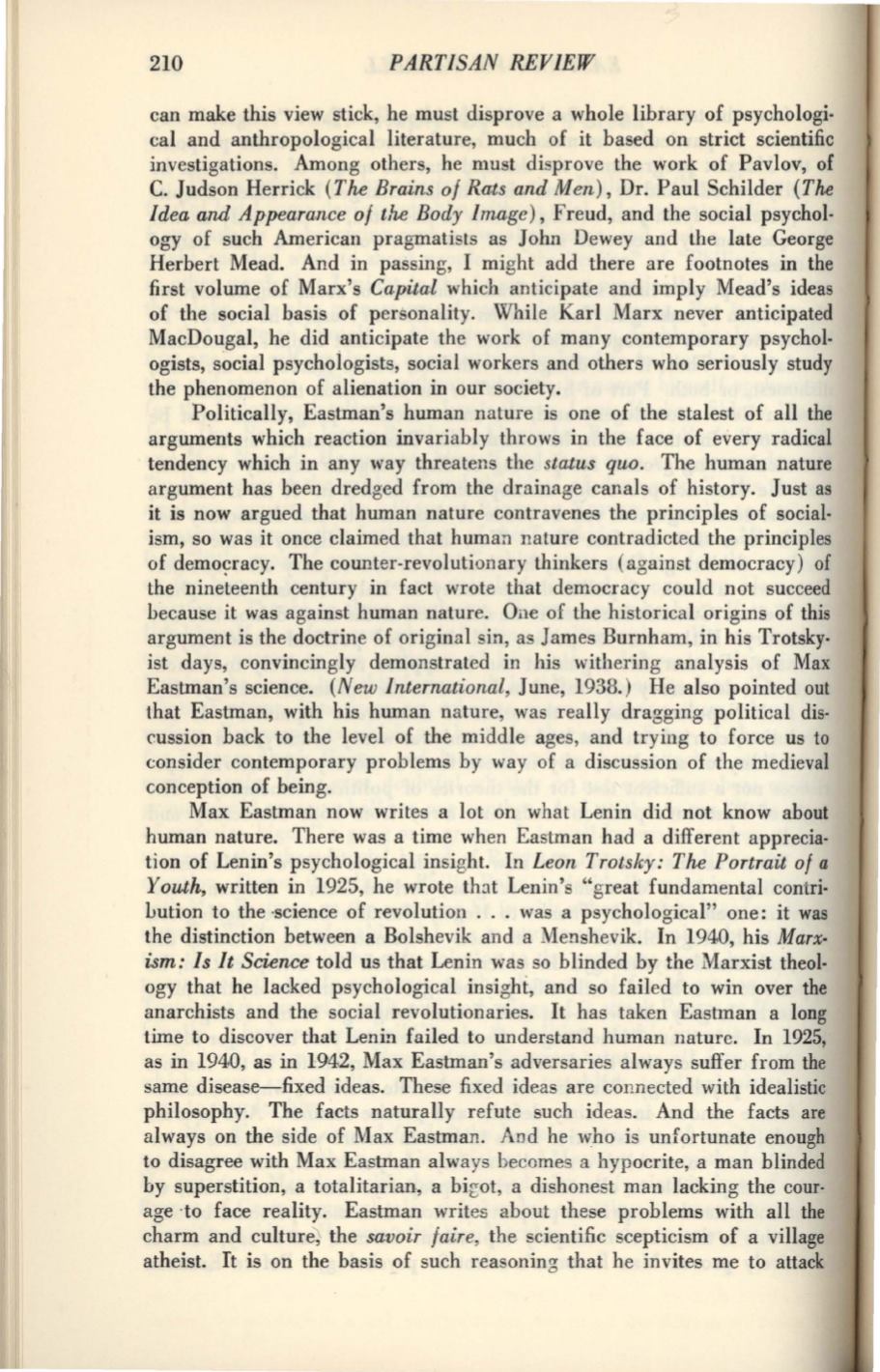
210
PARTISAN REVIEW
can make this view stick, he must disprove a whole library of psychologi–
cal and anthropological literature, much of it based on strict scientific
investigations. Among others, he must disprove the work of Pavlov, of
C. Judson Herrick
(The Brains of Rats and Men),
Dr. Paul Schilder
(The
Idea and Appearance of th,e Body Image),
Freud, and the social psychol–
ogy of such American pragmatists as John Dewey and the late George
Herbert Mead. And in passing, I might add there are footnotes in the
first volume of Marx's
Capital
which anticipate and imply Mead's ideas
of the social basis of personality. While Karl Marx never anticipated
MacDougal, he did anticipate the work of many contemporary psychol–
ogists, social psychoiogists, social workers and others who seriously study
the phenomenon of alienation in our society.
Politically, Eastman's human nature is one of the stalest of all the
arguments which reaction invariably throws in the face of every radical
tendency which in any way threatens the
status quo.
The human nature
argument has been dredged from the drainage canals of history. Just as
it is now argued that human nature contravenes the principles of social–
ism, so was it once claimed that human nature contradicted the principles
of
demo~racy.
The counter-revolutionary thinkers (against democracy) of
the nineteenth century in fact wrote that democracy could not succeed
because it was against human nature. One of the historical origins of this
argument is the doctrine of original sin, as James Burnham, in his Trotsky·
ist days, convincingly demonstrated in his withering analysis of Max
Eastman's science.
(New International,
June, 1938.) He also pointed out
that Eastman, with his human nature, was really dragging political dis–
cussion hack to the level of the middle ages, and trying to force us to
consider contemporary problems by way of a discussion of the medieval
conception of being.
Max Eastman now writes a lot on what Lenin did not know about
human nature. There was a time when Eastman had a different apprecia–
tion of Lenin's psychological insight. In
Leon Trots ley: The Portrait of a
Youth,
written in 1925, he wrote thnt Lenin's "great fundamental contri·
Lution to the ·science of revolution ... was a psychological" one: it was
the distinction between a Bolshevik and a Menshevik. In 1940, his
Marx·
ism: Is It Science
told us that Lenin was so blinded by the Marxist theol·
ogy that he lacked psychological insight, and so failed to win over the
anarchists and the social revolutionaries. It has taken Eastman a long
time to discover that Lenin failed to understand human nature. In 1925,
as in 1940, as in 1942, Max Eastman's adversaries always suffer from the
same disease-fixed ideas. These fixed ideas are connected with idealistic
philosophy. The facts naturally refute such ideas. And the facts are
always on the side of Max Eastman. And he who is unfortunate enough
to disagree with Max Eastman always becomes a hypocrite, a man blinded
by superstition, a totalitarian, a bigot, a dishonest man lacking the cour·
age ·to face reality. Eastman writes about these problems with all the
charm and culture, the
savoir faire,
the scientific scepticism of a village
atheist. It is on the basis of such reasoning that he invites me to attack


